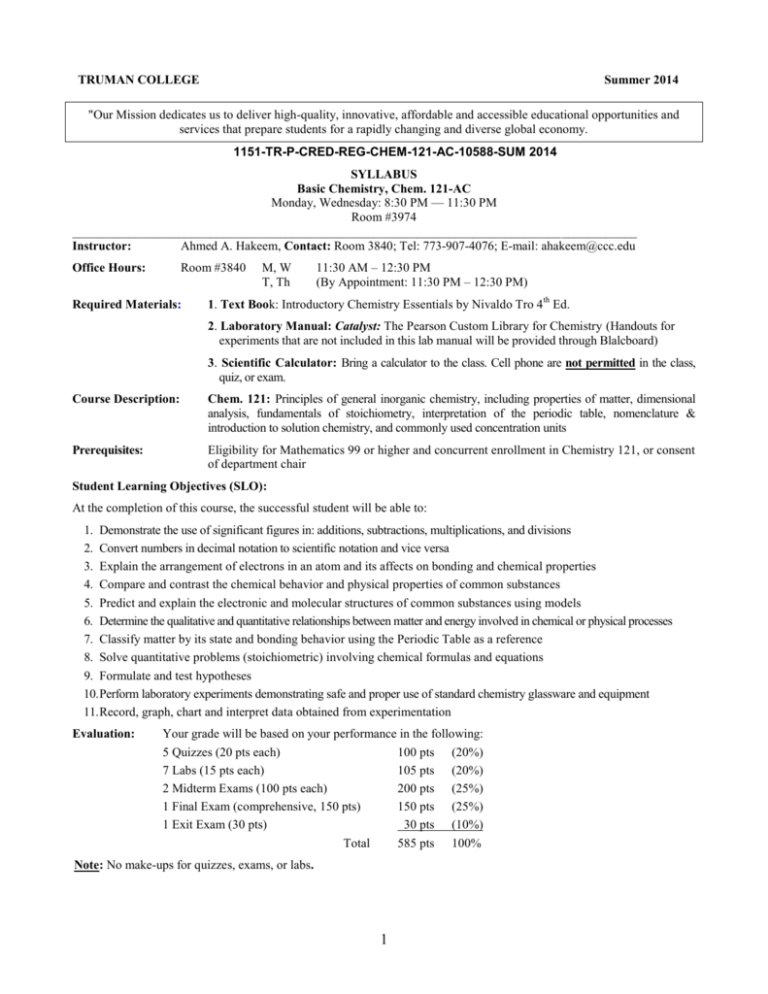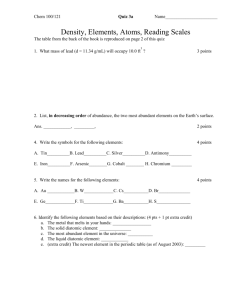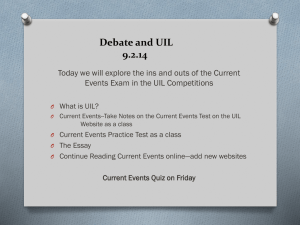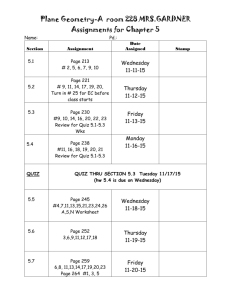Truman College
advertisement

TRUMAN COLLEGE Summer 2014 "Our Mission dedicates us to deliver high-quality, innovative, affordable and accessible educational opportunities and services that prepare students for a rapidly changing and diverse global economy. 1151-TR-P-CRED-REG-CHEM-121-AC-10588-SUM 2014 SYLLABUS Basic Chemistry, Chem. 121-AC Monday, Wednesday: 8:30 PM — 11:30 PM Room #3974 __________________________________________________________________________________________ Instructor: Ahmed A. Hakeem, Contact: Room 3840; Tel: 773-907-4076; E-mail: ahakeem@ccc.edu Office Hours: Room #3840 Required Materials: M, W T, Th 11:30 AM – 12:30 PM (By Appointment: 11:30 PM – 12:30 PM) 1. Text Book: Introductory Chemistry Essentials by Nivaldo Tro 4th Ed. 2. Laboratory Manual: Catalyst: The Pearson Custom Library for Chemistry (Handouts for experiments that are not included in this lab manual will be provided through Blalcboard) 3. Scientific Calculator: Bring a calculator to the class. Cell phone are not permitted in the class, quiz, or exam. Course Description: Chem. 121: Principles of general inorganic chemistry, including properties of matter, dimensional analysis, fundamentals of stoichiometry, interpretation of the periodic table, nomenclature & introduction to solution chemistry, and commonly used concentration units Prerequisites: Eligibility for Mathematics 99 or higher and concurrent enrollment in Chemistry 121, or consent of department chair Student Learning Objectives (SLO): At the completion of this course, the successful student will be able to: 1. Demonstrate the use of significant figures in: additions, subtractions, multiplications, and divisions 2. Convert numbers in decimal notation to scientific notation and vice versa 3. Explain the arrangement of electrons in an atom and its affects on bonding and chemical properties 4. Compare and contrast the chemical behavior and physical properties of common substances 5. Predict and explain the electronic and molecular structures of common substances using models 6. Determine the qualitative and quantitative relationships between matter and energy involved in chemical or physical processes 7. Classify matter by its state and bonding behavior using the Periodic Table as a reference 8. Solve quantitative problems (stoichiometric) involving chemical formulas and equations 9. Formulate and test hypotheses 10. Perform laboratory experiments demonstrating safe and proper use of standard chemistry glassware and equipment 11. Record, graph, chart and interpret data obtained from experimentation Evaluation: Your grade will be based on your performance in the following: 5 Quizzes (20 pts each) 100 pts (20%) 7 Labs (15 pts each) 105 pts (20%) 2 Midterm Exams (100 pts each) 200 pts (25%) 1 Final Exam (comprehensive, 150 pts) 150 pts (25%) 1 Exit Exam (30 pts) 30 pts (10%) Total 585 pts 100% Note: No make-ups for quizzes, exams, or labs. 1 Final Grades: Letter grades will be assigned as per the following: A 90% and above B 80%-89% C 70%-79% D 60%-69% F <60% Attendance: Your attendance is required at all classes. Excessive absences will result in your being dropped from the course or receiving an F. Quizzes: Each lecture quiz will cover the material discussed in the class pertaining to the chapter discussed. See attached tentative lecture and quiz schedule. Exams: There will be two midterm exams and one final exam. You must bring your own calculator, pencil, and eraser for exams. Cell phones should not be used at any time during the exam, even as calculators. Once the exam begins you may not leave the room unless you turn in the exam, so plan to take a bathroom break before the exam. Exit Test: In order to insure uniform expectations across all sections of Chem. 121 at Truman College, the department has instituted an ‘Exit Test’. There will be 30 multiple choice questions to be done in 60 minutes. 17 correct answers are needed in the exit exam to pass this course. Labs: The procedure for each experiment is fully described in the laboratory manual. Therefore, you must have your own copy of the laboratory manual to perform the experiments. You are expected to read the expt. before coming to lab. When assigned by the instructor, pre-lab questions will be due before the lab begins, and must be turned in before you will be permitted to start the lab. When post lab questions or reports are assigned, they will be due at the beginning of the next lab period, unless otherwise announced. Late lab reports score 0 for that portion of the lab grade. There will be no make up laboratory experiments. No pre-lab, post-lab, or data sheets will be accepted from students who miss the lab period. Lab reports should be neatly typed. Academic Dishonesty Academic dishonesty is a serious offense, which includes but is not limited the following: Cheating, complicity, fabrication and falsification, forgery, and plagiarism. Cheating involves copying another student’s paper, exam, quiz or use of technology devices to exchange information during class time and/or testing. It also involves the unauthorized use of notes, calculators, and other devices or study aids. In addition, it also includes the unauthorized collaboration on academic work of any sort. Complicity, on the other hand, involves the attempt to assist another student to commit an act of academic dishonesty. Fabrication and falsification, respectively, involve the invention or alteration of any information (data, results, sources, identity, and so forth) in academic work. Another example of academic dishonesty is forgery, which involves the duplication of a signature in order to represent it as authentic. Lastly, plagiarism involves the failure to acknowledge sources (of ideas, facts, charges, illustrations and so forth) properly in academic work, thus falsely representing another’s ideas as one’s own." - p. 39, CCC Student Policy Manual. Laboratory Outline: Objectives: 1. To introduce the students to laboratory experimentation/techniques 2. To increase the student's knowledge of the capabilities and limitations of measurements 3. To familiarize students with a variety of chemical reactions and the equations used to describe them 4. To give students laboratory experience in collecting and processing data Lab Rules: 1. Don’t come to the lab late. Wear protective goggles at all times in the laboratory work areas 2. Children are not allowed to stay in the laboratory 3. No eating and/ drinking is allowed in the laboratory 4. If possible, wear a laboratory apron to protect your clothing 5. After completing the experiment, clean and put away your glassware and equipment in designated areas/shelves. 2 Clean your work area and make sure that the gas and water are turned off 6. Dispose insoluble waste such as filter paper, litmus paper, matches in the wastebasket, and not in the sink. Dispose broken glass in the broken glasses boxes. Use dust pan and brush to clean the broken glass area. Dispose all other solid chemicals as directed by your instructor. Empty nontoxic liquids into the sink and wash them down with water. Pour all the toxic liquids into the waste bottles provided in the hoods 7. Do not take reagent bottles to your laboratory work area. Use test tubes, beakers, or paper to obtain chemicals from the dispensing area. Take small quantities of reagents. You can always get more if you run short 8. Check carefully the label on each reagent bottle to be sure you have the correct reagent. The names of many substances appear similar at first glance 9. To avoid possible contamination, never return unused chemicals to the reagent bottles 10. Do not insert medicine droppers into reagent bottles directly. Instead pour a little of liquid into a small beaker and use it 11. Try to be neat in your work; if you spill something, clean it up immediately. Ask for help, if needed 12. Wash your hands anytime you get chemicals on them and at the end of the laboratory period 13. Keep the balance and the area around it clean. Do not place chemicals directly on the balance pans; place a piece of weighing paper or a small container on the pan first, and then weigh your material. Never weigh an object while it is hot 14. Do not heat graduate cylinders, burettes, pipettes, or bottles with a burner flame 15. Do not look down into the open end of a test tube in which the contents are being heated or in which a reaction is being conducted 16. Do not perform unauthorized experiments 17. Every student should do the experiment individually unless otherwise indicated by the instructor Lab Reports: 1. Study the experiment carefully before coming to class, so that you don't have to spend a lot of time finding out what the experiment is all about. You must complete all pre-lab needed tasks of each experiment before you come to the lab. 2. Points will be deducted if you let someone copy your data or any part of the report. 3. The report must be clear, clean, and neat. The pages must be named and stapled together in a numerical order. It should include the following: A. Cover sheet: (Title Sheet) (Use sample posted on Blackboard) The cover sheet should appear as follows Course #:_____________ Section #: _______ Name of the Experiment: __________________________________________ Your Name: ________________ Date performed: ___________ Date submitted: _______ B. Abstract: A brief summary (not more than 5 sentences) of the experiment which includes what you did, the method used and a brief statement regarding your results or lack of. (1 pt) C. Methods: A narrative of the experimental procedure in your own words. Known procedures need not be rewritten. Rather the references need to be cited and any modifications done to the published method stated. (2 pts.) D. Results: A brief narrative of the experimental results. (2 pts.) E. Discussion: Discuss the relationship between your experimental results and the expected results. Give plausible reasons (not limited to experimental errors) for any differences. Include the relevance of the results and your experience doing this experiment in relation to the stated objectives. (3 pts.) F. References: List your sources. For example: Handbook of Chemistry and Physics, the proper citation of the handbook, texts or websites. (2 pts.) G. Figures, Tables, Data, Spectra: This section includes your tabulated data and results, calculations, graphs, and spectra. (2 pts.) H. Answer to questions: Pre and Post Laboratory questions (3 pts.) 3 Note: Laboratory performance points are included in the scores. Failure to follow correct laboratory techniques or laboratory safety protocols will reduce your score. *This is a lab course and as such you will need to satisfactorily complete labs in addition to maintaining the letter grade in order to pass this course. List of Lectures/Topics: Chapter 1: The Chemical World Chapter 2: Measurement and Problem Solving Chapter 3: Matter and Energy Chapter 4: Atoms and Elements Chapter 5: Molecules and Compounds Chapter 6: Chemical Composition Chapter 7: Chemical Reactions Chapter 8: Quantities in Chemical Reactions Chapter 9: Electrons in Atoms and the Periodic Table Chapter 10: Chemical Bonding Chapter 11: Gases Chapter 12: Liquids, Solutions, and Intermolecular Forces Chapter 13: Solutions Chapter 14: Acids and Bases List of Experiments: (Thursdays only) Expt # Topic 0. Introduction to chemical hygiene plan (CHP), safety instructions, and lab tour (eyes wash stations, fire hydrants, emergency showers, waste disposal, balances, andglassware), Lab check-in, Safety Quiz. 1. Laboratory Techniques/Measurements 2. Energy and Specific Heat 3. Freezing Points and Melting Points – Graphing Data 4. Analysis of Alum 5. Single Displacement Reactions 6. Double Displacement Reactions 7. Identification of Selected Ions Lab Clean up/checkout Tentative Schedule (Summer 2014) Below is a tentative schedule of lecture topics, labs, quizzes, and exams. The schedule/list of topics and lab experiments are subject to change. Students will be notified of changes, if any. Week Day Date Wednesday 6/4 Assessment test/ Syllabus Introduction of the Course/Gen. Chemistry Chapter 1: The Chemical World Thursday 6/5 Chapter 2: Measurement and Problem Solving Lab check-in, lab tour, safety instructions, Chemical Hygiene Plan (CHP), safety video clip, contract sign, safety quiz Monday 6/9 Chapter 3: Matter and Energy Tuessday 6/10 Ch 3 contd. Wednesday 6/11 Chapter 4: Atoms and Elements 1 2 Lecture Topic/Quiz/Exam/Lab 4 Thursday 6/12 Lab 1: Laboratory Techniques/Measurements (Hein’s Lab Manual) Monday 6/16 Quiz 1 (20 min. Ch. 1-2) Chapter 5: Molecules and Compounds Tuessday 6/17 Ch 5 contd. Chapter 6: Chemical Composition Wednesday 6/18 Ch 6 contd. Thursday 6/19 Lab 2: Energy and Specific Heat (Catalyst Lab Manual) Monday 6/23 Quiz 2 (20 min. Ch. 3-4) Chapter 7: Chemical Reactions Tuessday 6/24 Chapter 8: Quantities in Chemical Reactions Wednesday 6/25 Ch 8 contd. Thursday 6/26 Lab 3: Freezing and Melting Points (Catalyst Lab Manual) Monday 6/30 Exam 1(1 hr. Ch. 1-6) Chapter 9: Electrons in Atoms and the Periodic Table Tuessday 7/1 Ch 9 contd Wednesday 7/2 Chapter 10: Chemical Bonding Thursday 7/3 Lab 4: Analysis of Alum (Catalyst Lab Manual) Monday 7/7 Quiz 3 (20 min. Ch. 7-8) Chapter 11: Gases Tuessday 7/8 Ch 11 contd. Wednesday 7/9 Chapter 12: Liquids, Solutions, and Intermolecular Forces Thursday 7/10 Lab 5: Single Displacement Reactions (Hein’s Lab Manual) Monday 7/14 Quiz 4: (20 min. Ch. 9-10) Ch 12 contd. Tuessday 7/15 Quiz 5 (Take Home) Ch 11 (Gases) Chapter 13: Solutions Wednesday 7/16 Ch 13 contd. Thursday 7/17 Lab 6: Double Displacement Reactions (Hein’s Lab Manual) Monday 7/21 Exam 2 (1 hr. Ch. 7-13) Ch 14: Acids & Bases Tuessday 7/22 Lab 7: Identification of Selected Ions Questions/Answers / Review/Lab check out Wednesday 7/23 Final Exam: Chapters 1-14 (3 hr). Comprehensive, short answers /calculations along with multiple choice questions Thursday 7/24 Exit Test (1 hr), Comprehensive, 30 questions, multiple choice --------End of Semester--------- 3 4 5 6 7 8 5







